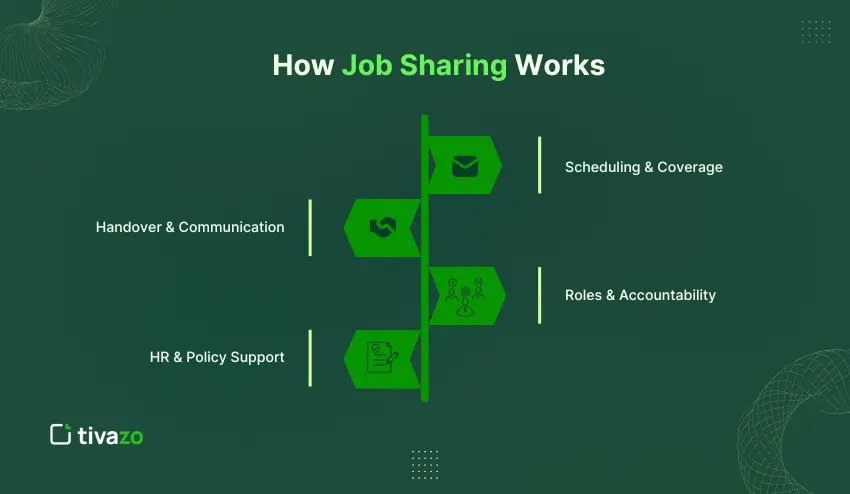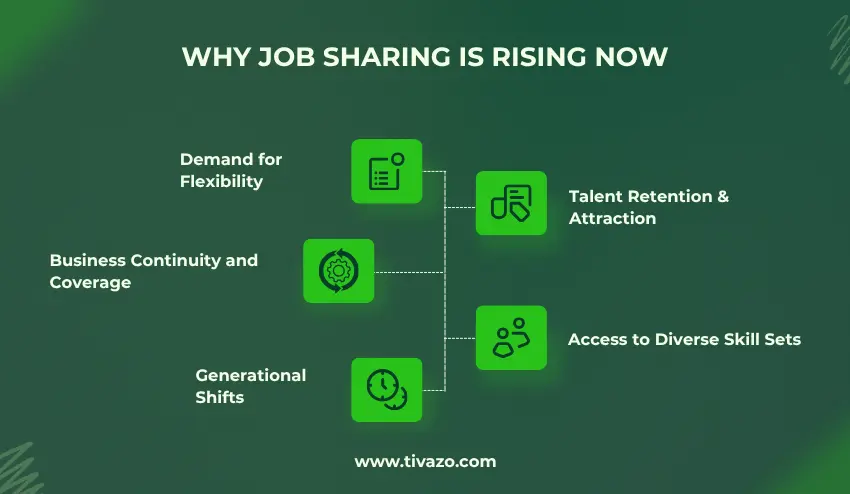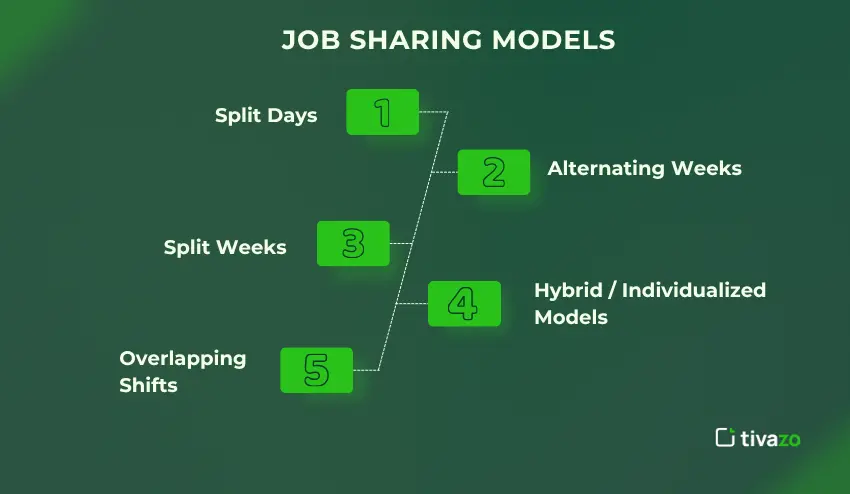The work places are changing at an unparalleled pace. The 9-to-5 work timetable is no longer considered a binding force to workers and organizations are finding out that flexible working hours can increase productivity besides employee satisfaction. One of the most popular methods that are emerging is job sharing.
Job sharing is where two people share the responsibilities of one full time job. The employees both share tasks, hours and goals compared to the tasks being carried out by one individual. This provides a balance in which the employees are more flexible and the employers do not lose complete coverage of the position.
This blog will explain what job sharing is, how it works, its pros and cons and why it can be the best answer to businesses and employees who want to find more balance in their work life.
What Is Job Sharing?
Job sharing in its essence is a flexible working arrangement that entails two employees sharing the duties of one full time job. The 40 hours a week that one individual works may be divided into 20 hours each by two persons. The timing may be different, but the concept is the same, the two workers work jointly to do a single job.
Job sharing is not such as part-time work. Part-time work is where a single worker is left to only do their work at a smaller time. In job sharing, two individuals share the same job, work and results. This implies that communication and coordination are important, since both employees must remain focused on objectives and tasks.
An example would be to have one individual work mornings and the other afternoons. Or they could divide the week, one Monday-Wednesday and the other Wednesday-Friday. This will give the position twenty-four-hour coverage without overworking an individual.
How Job Sharing Works (Day-to-Day Mechanics)
Job sharing is effective in that it splits one job in two employees in that the duties, the time and the targets are shared. Effective job sharing should be accompanied by effective communication, schedules, and handover procedures.

1. Scheduling & Coverage
- Split days: A single worker works in the morning, the other in the afternoon.
- Split weeks: Each worker works on a specific number of days of the week.
- Shifts overlap: Both shifts work together during a section of the day to provide continuity and handovers.
- Alternating weeks: Every employee is on a rotation where he or she works full weeks.
2. Handover & Communication
- Responsibilities are tracked using shared tools such as calendars, task lists or project management software by employees.
- Frequent handover meetings can be used to clarify the tasks to be completed, progress, and future priorities.
- Documentation is important in ensuring that there are no gaps in work.
3. Roles & Accountability
- Employees are not duplicated or confused by having a defined role in each.
- The performance goals are equated to the common position hence both are responsible to the overall results.
4. HR & Policy Support
- Organizations give instructions of scheduling, communication and evaluation.
- HR takes care of the legal obligations, compensation, and payroll modifications of the shared arrangement.
Example:
A SaaS company has two marketing managers in one position. One works on the content creation and outreach to clients in the mornings, and the other works on the analytics and campaign management in the afternoons. They also overlap one hour a day in handovers and weekly meetings to synchronize strategies. This arrangement ensures continuity as well as provides flexibility to both employees.
Why Job Sharing Is Rising Now
Job sharing is not a trend, it is an adaptation to the changing demands of the employees and the organization. Its popularity is being fueled by several factors:

- Demand for Flexibility
Employees are becoming more and more interested in flexible schedules that enable them to have a work-life balance, post-pandemic. Job sharing also provides them with a chance to work fewer hours without quitting the organization. - Talent Retention & Attraction.
Firms that provide job sharing get the top talent who would otherwise be lost to the inflexible full-time requirements. It is also useful in retaining experienced employees who would wish to reduce hours temporarily. - Business Continuity and Coverage.
Organizations have regular coverage of critical positions by sharing duties between two workers. This minimizes the chances of deadlines being missed or burnout. - Generational Shifts
The younger generations, Millennials and Gen Z, are more concerned with work-life balance and flexibility. Job sharing is acceptable to them and it is also able to satisfy the needs of the organization. - Access to Diverse Skill Sets
Having two employees in the same position may introduce complementary skills, views, and experiences to a job and improve on the overall performance and innovation.
Example:
A technology firm adopted job sharing among software developers as a way of minimizing burnout. There was no decline in productivity, there was also a reduction of 15 percent in absenteeism and employees also registered higher job satisfaction scores.
Job Sharing Models (with Real Examples)
Job sharing can be structured in several ways depending on the organization’s needs and the nature of the role. Understanding these models helps employers design arrangements that work for both the company and employees.

1. Split Days
- One of the employees works in the mornings and the other employee works in the afternoons.
- Best suited to a position that needs full-day coverage like a customer service or support staff.
- Example: A customer support division divides the shifts in a way that the calls are picked between 8 AM and 8 PM without overloading one employee.
2. Split Weeks
- The employees cover certain days of the week.
- Performs well in project-related jobs or in administration.
- Example: Two administrative assistants have a five-day workweek: Employee A works Monday-Wednesday, Employee B works Wednesday-Friday.
3. Overlapping Shifts
- Part of the day is spent by employees working together to maintain continuity.
- Handovers, meetings and collaboration can be achieved through overlap.
- Example: Two project managers overlap an hour a day to talk about current work and make sure that no deadlines are missed.
4. Alternating Weeks
- Working full weeks are alternating.
- Fit to be in leadership positions or jobs that need continuous attention.
- Sample: Two top managers switch every week, so that there is a leader present, and each has long flexible time.
5. Hybrid / Individualized Models
- Personalized plans depending on job specifications and the employee needs.
- May combine split days, weeks or certain project duties.
- Example: A marketing department has one employee working on campaign strategy and the other employee working on analytics but they have some overlap in important planning sessions.
Hint: The type of model to use depends on the workload, the deadlines, and the degree of collaboration.
Employer ROI: Business Case of Job Sharing.
Job sharing is not only good to employees, but can also provide quantifiable value to employers. Strategic sharing of roles helps companies to save on costs, retain talent and remain productive.
1. Reduced Turnover Costs
The cost of employee turnover is high. Recruiting, hiring and training replacements may cost 50-200 percent of the annual salary of an employee.
Job sharing enables the employees to reduce the number of hours rather than quitting the organization, reducing turnover expenses.
Example: A firm that has an employee earning $70,000 can save up to 35000 dollars in turnover expenses by allowing the employee to switch to job sharing rather than resigning.
2. Greater Productivity and Continuity.
Two employees in the same role will be able to work more hours without overworking either.
Minimizes absenteeism and makes sure that deadlines are always observed.
Example: Missed tickets in a tech support team decreased by 20.
3. Improved Retention and Engagement of Talent.
Adaptability enhances contentment and loyalty.
Workers tend to remain longer in a company that has work life balance.
4. Access to Diverse Skill Sets
The synergy of two employees can enhance the performance of the whole team.
Example: One partner can be more effective in communicating with the clients, the other in analytics, which will lead to a better result than one employee would have achieved.
5. Cost-Benefit Overview (Simple ROI Formula)
ROI=Benefits (Retention + Productivity gains) – Costs (Training + Coordination) Costs×100ROI=The Benefits (Retention + Productivity gains) – Costs (Training + Coordination)/100
Pros: Lower turnover expenses + increased productivity + increased engagement.
Expenses: Two employee training, schedule organization, some administrative changes.
Example Calculation:
Retention savings: $35,000
Productivity gain: $10,000
Coordination/training cost: $5,000
ROI = (($35,000 + $10,000) – $5,000) ÷ $5,000 × 100 = 800%
This goes to show that, when done right, job sharing can be a high-ROI organizational strategy.tions.
Employer Framework: 7 Steps to Job Sharing.
Job sharing can only be successfully implemented in a structured way. The following is a step-by-step model that employers may use:
- Identify Suitable Roles
Consider what jobs can be shared successfully.
Ideal roles are characterized by tasks that are well defined, measurable and do not require close supervision.
The roles that necessitate full-time attendance or high confidentiality should not be undertaken unless the handovers can be well-structured.
- Formulate Policy/HR Guidelines.
Develop official policies regarding eligibility, scheduling, performance expectations and benefits.
Make sure that labor laws, payroll and benefits adjustments are done in accordance with the law.
- Assign Job Share Partners
In this phase, employees are paired together in a manner that their skills, workstyle, and personalities complement each other.
Be sure to assign employees utilizing a compatibility matrix or survey.
Ownership of the schedule warrants improved commitment therefore allow the partners to self manage.
- Pick a Schedule and Hand-Off Process.
You can choose to split days, or split weeks, overlap or create a hybrid schedule.
Create an assignment hand-off process that includes documenting the process, meetings and check in process.
- Create Communication and Accountability Guidelines.
Together the role partners can share resources like calendars, task listings or project management software.
Make the reporting and split responsibilities of each partner clear to prevent redundancy or gaps in coverage.
- Start with a Pilot with KPIs.
Implement a trial at the start of the arrangement.
You will want to capture, record and obtain data on performance, satisfaction with the arrangement, and KPs coverage whilst ensuring the KPIs are quantifiable.
- Review, Adjust, and Scale
Get employee and manager feedback.
Modify schedules, duties or policies accordingly.
Increase job sharing to other jobs in case of success.
Example:
One of the jobs that were piloted in a job share was that of a content manager in a marketing department. After 3 months of the trial, they reported that there was a 15 percent increase in content output and the team collaboration improved.aboration, and higher employee satisfaction. Based on results, the company rolled out similar arrangements across other mid-level roles.
Global & Legal Considerations
Job sharing policies and adoption vary widely depending on the country, labor laws, and cultural norms. Employers need to understand these factors to implement job sharing effectively.
1. United Kingdom & European Union
- Employees often have a legal right to request flexible working, which can include job sharing.
- Employers must consider contractual obligations, benefits, and working hours compliance.
- Cultural acceptance is higher; job sharing is fairly common in education, healthcare, and public sectors.
2. United States
- No federal law specifically mandates job sharing; implementation is generally at the employer’s discretion.
- Organizations must ensure compliance with wage, benefits, and overtime regulations.
- Adoption is slower, but flexible arrangements are increasingly valued in tech, professional services, and healthcare.
3. Asia & Other Regions
- Job sharing is less common due to traditional full-time work norms and cultural expectations.
- Organizations may face resistance or logistical challenges when implementing shared roles.
- Pilot programs with clear policies and communication can help overcome cultural barriers.
4. Key Legal Considerations
- Contracts: Define hours, responsibilities, benefits, and performance expectations for each employee.
- Benefits: Ensure fair allocation of health insurance, leave, and retirement contributions.
- Payroll: Adjust compensation accurately according to shared hours.
- Compliance: Follow local labor laws regarding overtime, holiday pay, and termination rights.
Tip: Consulting legal or HR experts before launching a job-sharing program can prevent costly mistakes and ensure alignment with local regulations.
Common Mistakes & How to Avoid Them
Well-intended job sharing programs can easily fail unless they are handled appropriately. The following are the pitfalls that are common and how the employers can avoid them:
- Poor Partner Matching
Error: Matching employees with conflicting work styles or commitment levels.
Resolution: Before finalizing, use tests, trial, or manager feedback.
- Vague Role Definitions
Error: No clarity on responsibilities resulting to overlapping or gap.
Solution: At the beginning clearly define tasks, ownership and deliverables per partner.
- Weak Communication Systems
Fallacy: Trusting in unofficial conversations or random news.
Solution: Have formal handovers with shared documentation, calendars and planned check-ins.
- Inadequate Training for Managers
Error: Assuming that managers know how to manage teams that work under a shared approach.
Solution: Provide guidance for monitoring their performance, belief expectations, and dealing with conflict.
- Ignoring the Legal and HR Implications.
Error: Failing to pay attention to contracts, benefits, or payroll issues.
Solution: Partner with HR/legal to create standard practices for hours, benefits, and compliance.
- No Metrics for Curating Success
Error: Not having a way to measure results complicates justifying or scaling the program.
Solution: Identify some Key Performance Indicators (KPIs) to monitor outcomes. For example, productivity, retention and/or customer satisfaction, etc.
Conclusion
Job sharing is not a mere flexible work arrangement but rather a viable solution that helps to balance the needs of the employees and the business objectives. To the employees, it provides access to a higher work-life balance without compromising on career advancement. To employers, it serves to retain talented employees, save turnover expenses, and enhance productivity by having two professionals in one job.
The trick is in its proper organization, the appropriate tools, and the culture of collaboration. By implementing job sharing, organizations not only get to access the best talent, but also make themselves look progressive and people-oriented.
Job sharing should be on your HR strategy list in case you are seeking new methods of adapting to the contemporary workforce. Begin small, pilot it, perfect it–and see it change your workplace culture, as well as your bottom line.




